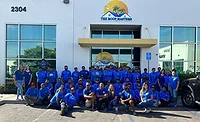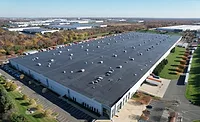Southern Roof & Wood Care Corp. Masters the Basics


The company has been around since 1984 and, as the name would imply, had its beginning in the business of pressure washing wood shake roofs, decks and siding. Today Southern Roof & Wood Care specializes in metal panel roofing (various styles of standing seam, flat-lock, etc.), flat work (built-up, modified, EPDM, TPO and PVC), concrete and clay tile, and slate. The company also does shingle work. Recently, Southern Roof & Wood Care has focused on several condominium and school projects.
Swanson and Harris purchased the company in 2000 and in the beginning, prospects were bleak. “It quickly became clear that the predecessor company had given one person sole responsibility for sales — the estimator. In fact, he was the face of the company; not even the prior owner was actively involved in the sales and marketing,” Swanson explains. “Unfortunately, this estimator had been aware that the business was for sale and he had been working on the side for many months in preparation. These actions not only reduced the rate of growth in back-logged sales, but also increased the amount of incorrectly bid jobs. Needless to say, we were dealt a very poor hand.”
Within a month, the estimator was gone. As Swanson viewed the situation, Southern Roof faced a dilemma: “Do we hire an experienced roofing estimator and inherit his or her way of estimating, or hire an intelligent but inexperienced person?” Each option had its advantages and pitfalls. “Experience could bring short-term sales and long-term headaches. Inexperience would require significant training, could cost us dearly in terms of lost sales, and might backfire if the wrong person was selected,” says Swanson. In the end, he decided to go with a novice. “I hired a young, energetic person with a college degree and a working background in accounting.”
Swanson says the training process was “long and arduous” and that the two of them still have a lot to learn. However, “We were able to overcome shortcomings and create an effective estimating/sales solution.” The result? Southern Roof is on track to more than double its first year’s sales numbers and has achieved a higher net profit margin per dollar of sales.
Southern Roof now employs 35 to 40 workers at peak time and its sales volume is between $1 million to $2 million. Commercial sales represent approximately 80 percent of sales and residential reroofing and repairs make up the balance.

Key Ingredients
No one believes that running a roofing business is easy and Swanson sees several reasons for Southern Roof’s success. For one thing, both Swanson and Harris have advanced business degrees and other employees are college educated. “Southern Roof & Wood Care Corp. is run like a business first and a roofing company second,” Swanson explains. “Thus, we have been able to improve internal processes, reduce costs, enhance marketing capabilities and increase productivity.”Staffing is obviously the crucial element. “Our staff makes us successful every day,” says Swanson. “Although our leadership might make a good initial impression, our long-term tenure in the marketplace is based on the rest of the team performing for our customers daily. I am fortunate to have a group of very bright, dedicated and honest individuals who make a great team.”
According to Swanson, Southern Roof has also built up a solid reputation with general contractors — both local and out of town — who typically demand quality, coordination, administrative support and the ability to meet a stringent schedule. It also helps that Southern Roof has a complete offering of roofing products. “Numerous jobs have required the combination of standing-seam panels, modified flat roofing, wall panels, coping, gutters and downspouts,” Swanson says. “This competence separates us from the pack of lesser-qualified roofers working out of their trucks.”
And it doesn’t do a company much good to offer diversified products and services if it doesn’t stand behind its work. “If we err in estimating or installing a job, we absorb the financial strain and look to the future,” says Swanson. Of course, the idea is to be as accurate as possible in the first place. To that end, Southern Roof purchased The Edge — an estimating software program from Advanced Estimating Systems Inc. — in late 2000. Swanson finds that the computer-generated plans streamline the process and allow for faster turnaround time.
Another key to Southern Roof’s success is its dedication to safety. The company holds weekly meetings reviewing safety-related topics (toolbox talks, etc.) and gives its employees parties for accident-free months. “This helps keep everyone focused on maintaining a safe workplace,” says Swanson. “Additionally, we are in the process of incorporating an OSHA-funded NRCA safety program that was introduced earlier this year.”
Finally, Swanson cites the fact that Southern Roof has a solid working and financial relationship with distributors. “One of the most solid distributors in our market is JGA Southern Roof Center,” he says. “Their service and support has been exemplary.”
Speed Bumps
Success is never easy, of course, and Swanson points out a few challenges facing the industry today. For one thing, he sees the influx of foreign workers as both a blessing and a curse. “(Legal) Hispanic immigrants are typically quick learners that are dedicated to their profession. The increase in the immigrant population has enhanced the local labor pool, but it has also increased competition as employees of roofing contractors venture out on their own,” Swanson explains. “Thus, our ability to retain staff and sell our knowledge base to the customer is a critical asset.”Competition in general is always a fact of life and Swanson mentions that the Southeast coast has seen tremendous growth over the past decade. “As the national economy faltered in 2000-2001, our specific market (which is a bit less susceptible) got quite crowded with the entry of various roofing contractors from other regions of the country that were affected by the downturn,” Swanson says. “It will be interesting to see if these newer players return home once the economy rebounds.”
Though liability and worker’s comp insurance is the hot topic of the day, Swanson finds employee benefits more of a problem. “Our company has always offered a very generous benefits package that includes full health insurance coverage; however, the substantial increases in insurance rates are making it quite difficult to maintain such an offering,” he says. “Asking an employee to cover his or her dependent health insurance coverage isn’t difficult to do when coverage amounts to a $10 per week contribution. Try it when the rates soar to $150 per week!”
One rather incomprehensible problem that Swanson has run into is what he terms “out-of-sequence” construction — where general contractors are building-out the interiors of buildings before the envelope is waterproofed. “It is amazing how many buildings today have drywall, insulation, wiring, etc., installed before the roofing is anywhere close to complete,” he says.
In a recent incident, Southern Roof was contracted to install a 200-plus-square Verisco 0.060 EPDM roof and more than 65 squares of metal coping. “Upon receiving directive to begin, we arrived on the site and found the drywall installed on the first two floors of the building,” says Swanson. “Needless to say, when it rained the first week of the project, the site supervisor called us and asked, ‘Who’s going to pay for this drywall damage?’” He continues, “If this is indeed a trend, imagine the implications on roofing contractors. The documentation required to prove start dates, general contractor’s ineptness, etc., would be overwhelming. With the recent flood of toxic mold lawsuits, could a roofing contractor be held liable for damage created during the construction phase, even if once installed, the roof system is competent and watertight? If a precedent is set, once can only imagine how difficult it will be to obtain liability and or commercial umbrella insurance.”
Case Study
One of Southern Roof’s recent projects is the Grandview on Skull Creek, Hilton Head Plantation, Hilton Head, S.C. It is a high-end condominium project located in an exclusive plantation on the Intra-Coastal Waterway. This project is being constructed by R. J. Griffin Inc. of Atlanta. Units are on the market from $850,000 to more than $2 million.Southern Roof won the job via a competitive bid. According to Swanson, “The general contractor not only spent numerous hours on the phone during the pre-qualification stage, but also took the time to interview our key employees in person before awarding the job. The fact that we had successfully completed other large, high-profile condominiums in the area, which were constructed by other non-resident general contractors, helped them make the decision.”
The total project involved over 600 squares of roofing. Southern Roof installed Tamko 60-mil MoistureGuard Plus tile underlayment and Monier Patina Green Country Slate Concrete Tiles. The company also custom-fabricated four different colors of 0.032 aluminum flashings, drip edge, fascia, and copings made from flat stock supplied
by Integris Metals. The project also called for GAF I-2-1-MGP Modified Roof systems, 0.027 K-style aluminum gutters, 0.024 rectangular aluminum downspouts and UnaClad 0.040 UC-4 standing-seam panels.
“In order to meet local building codes on the tile installation, we used two fasteners per tile and hurricane clips (using two fasteners per),” explains Swanson. “Extensive shop drawings were required and inspected by not only the general contractor, but also the architect, owner, and an independent waterproofing company hired by the general contractor.”
To date, the project has been a big success. “The general contractor’s site supervision has been superb,” and if someone were to visit the site, Swanson says, he or she “would immediately appreciate the quality of construction.” At the end of the day, that’s what matters most.
Looking for a reprint of this article?
From high-res PDFs to custom plaques, order your copy today!






